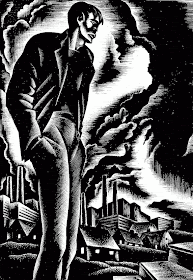Vasant Sarwate (वसंत सरवटे) writes in Marathi (मराठी) magazine Lalit (ललित) September 2013:
"...in summation, it can be said that Marathi person enjoys auditory experience more than visual experience An average Marathi person engrosses in music very well. Very little in pictures. Almost none. It's certainly true of ordinary people. But even those writers, poets and critics who are celebrated in Marathi literature, are well known for their talent can't see pictures on the cover and those (if they exist) inside. Let the book be of the other authors' or their own ! Then appreciating them remains a remote thing..."
("...एकूणात, मराठी माणसाला दृश्यापेक्षा श्राव्य अनुभव अधिक भावतात, असं म्हणता येईल. सामान्य मराठी माणूस संगीतामध्ये उत्तम रंगतो. चित्रांच्यामध्ये फारच कमी. जवळजवळ नाहीच. सर्वसामान्यांच्या बाबतीत तर हे खर आहेच. पण मराठीमध्ये साहित्याचे जाणकार म्हणून किर्ती मिळवलेल्या , प्रतिभावंत म्हणून मान्यता प्राप्त झालेल्या लेखक, कवी, टीकाकार यांना मुखपृष्ठावरच आणि (असतील तर) पुस्तकाच्या आतील चित्र दिसतच नाहीत. पुस्तक इतर लेखकांचे असो किंवा त्याचं स्वतःच असो ! मग त्यांचा आस्वाद घेण तर दूरच...")
I have already written more than one post on the subject. Most volubly here on November 9 2010.
I wish to give another example before I go ahead.
I often read parts of G A Kulkarni's (जी ए कुलकर्णी) book 'Pinglavel' (पिंगळावेळ). I have a copy of its first edition published in 1972. Its cover is striking.
I noted recently that the book does not even mention who the cover artist is! One has to figure out from the artist's signature on the cover. And this is from the author who, according to Vasant Sarwate, was a man of learning in visual arts and was himself a painter of some caliber.
Artist: the late Prabhakar Gore (प्रभाकर गोरे)
Art Spiegelman wrote on October 13 2010:
"...In a pervasively influential eighteenth-century essay, Laocoon: or The limits of Poetry and Painting, by the German aesthetician, Gotthold Lessing, Western culture was admonished against confusing between the nature of poetry or prose—written forms whose province is time, and the nature of visual forms like painting and sculpture, whose province is spatial..."
Since Marathi people enjoy music so much, is music too a form whose province is time and NOT spatial? And is there an art form that works well in both the provinces of time and space?
"...Nothing could violate this long-held aesthetic taboo more directly than comics, a kind of picture-writing—the very layout of a comics artist’s page insists on pulling the reader from one drawing to the next. (Lynd) Ward also trafficked in time, of course, but by inviting the eye to rest on each isolated composition—unsullied by written language—he was sneakier about it..."
Artist: Lynd Ward

